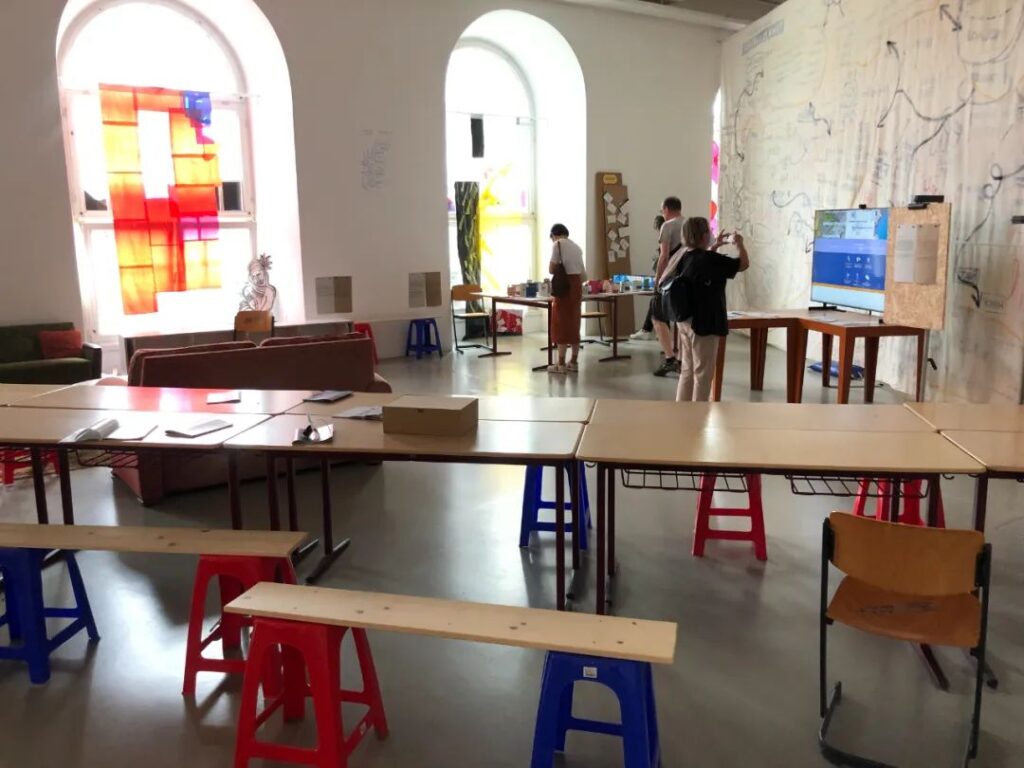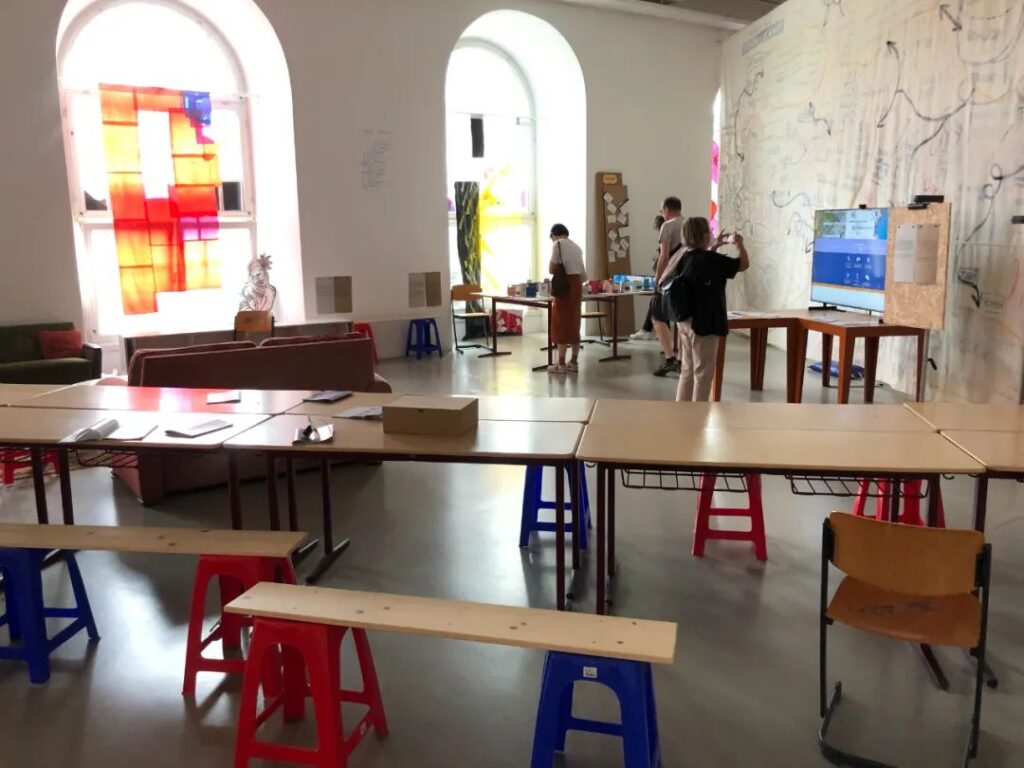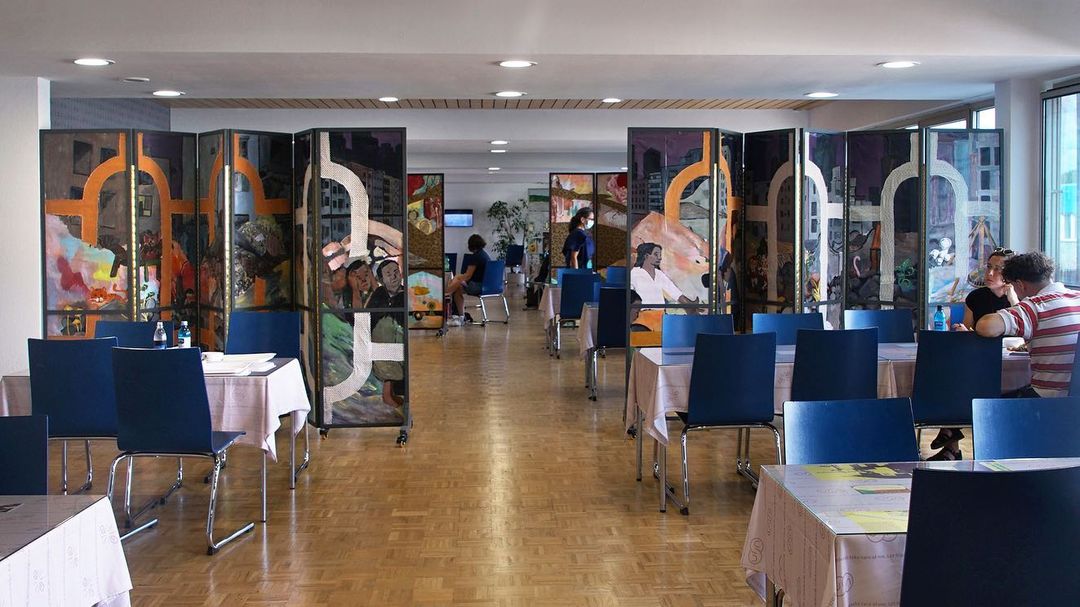Spillover and Spillover Governance at Documenta in Kassel, by Liu Weitian
。。。English translation below 。。。
当代艺术的边界在加速扩张,边界本身逐渐失去原有的意义,用于划分领土的界线成为双向侵蚀滋长的浑浊地带。溢出和污染在此处发生。伴随着边界的瓦解,中心与边缘的关系失去了支撑,领域自身的连贯性破裂了。矗立在艺术世界中心位置,继承了辉煌遗产的利益相关者们仍然幻想着对边界和疆域的掌控,尽管他们脚下的地面已经出现裂缝。
我们熟悉的关于“艺术”的知识越来越无法帮助我们理解所处的状况,“艺术作品”或是“艺术创作”这样的词汇愈发显得画蛇添足、不合时宜。敏锐的艺术史学者和艺术批评家尝试理解正在发生的变化,并通过历史和理论写作来修补裂缝、重整秩序。他们看似乐于见到艺术边界的扩张,并积极地参与到这项事业中,可是这样的工作往往建立在对于边界本身的敬意和怀念之上。由此生产出的叙述和理论不足以帮助我们理解事情的全貌。比如,对“艺术介入社会”的历史叙述和号召远赶不上艺术的边界化解于真实世界中的速度。当保护着艺术的壁垒已经形同虚设,“艺术介入社会”只是帮助艺术挽回些许颜面的伪命题。
在一些利益相关者的努力下,新的名词和分类法被源源不断地生产出来,演变成为新的艺术范式进入艺术生产的说明书,同时亮相于艺术市场的标签和图录中。尝试参透并掌握溢出的部分是有价值的,因为新的话语和新的历史建构是争取未来的必要途径。然而,参透和掌握的冲动是值得警惕的,因为这种冲动的驱动力往往是与资本主义相伴相生的驯服-殖民逻辑。这套逻辑支撑着一个强大的防御和生产系统,它试图将一切溢出之物裹挟、削弱、中和、利用,改造为让艺术世界保持活力的养分,而学术研究是这套系统中的重要工具。
所谓“激进”艺术实践的内在矛盾也体现在这里:随着“激进”在艺术话语中被赋予越来越多的价值,艺术系统通过收编那些关于激进思想的作品和展览,将艺术的“激进”从社会现实中剥离开。不难发现,“激进”术语已悄然成为艺术世界的新宠儿,它们在学术论文和艺术市场间穿梭自如,在作品和展览介绍中轮番登场,它们一边为知觉钝化的当代知识人带去自我满足的刺激感,一边为艺术家和策展人提供在当今艺术世界穿行、爬升的信用额度。艺术系统由此升级为一场金融游戏,行动与变革在虚拟的游戏世界里彻底让位于估值与投机。[1]
艺术自主和社会介入的二元对立在今天已经没有意义。艺术的自主性面临的危机被新自由主义管理艺术的先进手段逐一化解。这同时也是一项心理和情感层面的治理术,它将自主性无法完成的使命通过对自我升值和自我实现的执着追求交付给艺术世界的每个公民,使其自觉、虔诚地维护艺术的尊严,由此实现对艺术边界区域浑浊成分的净化和回流。在这个意义上,溢出意味着逃离新自由主义治理术对情感的管理,将艺术公民的虚荣心和羞耻感抛之脑后。
第15届卡塞尔文献展就是一个溢出的艺术现场,溢出与溢出治理在此角力。担任策展人的印尼艺术团体ruangrupa将“lumbung”(印尼语里意为“米仓”)作为此次文献展的核心理念。在印度尼西亚的农村,村民们将收获的多余粮食储存在由大家共同管理、共同使用的粮仓。取义于这一做法的lumbung所包含的意义超越艺术的范畴,它涉及到的包括共同生活和资源分配在内的问题指向对社会结构的思考和实验。

尽管超越个人主义的集体工作模式在近几年的当代艺术讨论中开始受到关注,现有的对于“艺术团体”的理解却往往只是狭隘地将其视作一种新的艺术形式,或是简单地将其归结为从个人独立创作到多人合作的转变。与其说这一视角忽视了集体工作模式之于社会结构的深远意义,不如说它在有意回避关于艺术基础结构以及社会运作机制的讨论,从而在自己划定出的狭小框架下获得一丝稳定和安全感。此届文献展排除了这些形式主义讨论的干扰,直接击中问题的要害:如何彻底摆脱殖民主义遗产——剥削关系、所有权、独立于他人的个人主权和自由意志——对我们认知世界的限制,从而想象和建立一个新的共同存在的方式?
可贵的是,ruangrupa不满足于展示和呈现关于“米仓”的实践,而是将“米仓”作为实践方法组织整个文献展。如果说前者是当下的“学术-艺术综合体”最习以为常的对待溢出的方式,那么后者则是一次对艺术系统的扰乱。[2]对于高度专业化的西方艺术系统来说,这样的扰乱无疑会引起困惑和不适,甚至是恐惧和敌意。当溢出的规模和程度超过了利益相关者们(请注意“股东”在文献展反犹争议事件中扮演的角色)的容忍限度,治理溢出的机器便启动了。
对于受邀参展的艺术家来说,如何处理自己的实践与艺术展览和观众们的关系亦是一项挑战。实践与艺术语境下的作品以及机构框架中的公共项目并不兼容,展示和再现的逻辑也很难捕捉实践中最为关键的工作方法以及维系着实践的社会关系。于是,各式各样的手绘思维导图,以及散落在房间醒目位置的长桌和长凳,成了此届文献展中突出的元素。这些“展品”邀请观众们想象那些溢出于展览之外、无法被物化的相聚,同时也讽刺地揭示了展览逻辑自身的局限。
ruangrupa对艺术系统自身的标准和期望并非毫不在意;相反,ruangrupa深知西方艺术世界的焦虑和渴望,并且敢于深入这一系统的内部进行搅动,在错综复杂的共谋关系中为“溢出”开辟通道。在这个意义上,此次文献展的意义不在于扩展了艺术的领域,而在于进一步松动了把守着艺术边界的阀门,让溢出在新的溢出治理术被发明和实施之前,朝着不可预估的方向加速发生。
[1]有趣的是,英文中“portfolio”一词既可指艺术家的作品选辑,也可指个人或机构的投资组合。
[2]“学术-艺术综合体”(academic-artistic complex)这一说法来自Fred Moten与Stefano Harney合著的文章“Suicide as a Class”,详见All Incomplete, Minor Compositions出版社, 2021年, 148页。
刘伟田,《歧路批评》的编辑之一。
。。。
The borders of contemporary art are expanding at an accelerated rate, the borders themselves are losing their original meaning and the boundaries that demarcate the territory are becoming a murky zone where erosion grows in both directions. Spillover and pollution occur here. With the disintegration of borders, the relationship between centre and periphery loses its support and the coherence of the field itself breaks down. Stakeholders who stand at the centre of the art world and inherit a glorious legacy still have illusions of control over borders and frontiers, despite the cracks in the ground beneath their feet.
Our familiar knowledge of ‘art’ is increasingly unable to help us understand the situation, and terms such as ‘artwork’ or ‘artistic creation’ are becoming increasingly irrelevant and anachronistic. Keen art historians and art critics are trying to understand the changes that are taking place and to mend the cracks and reorder the situation through historical and theoretical writing. They seem happy to see the expansion of artistic boundaries and are actively engaged in this enterprise, but such work is often based on a reverence for and nostalgia for boundaries themselves. The resulting narratives and theories are insufficient to help us understand the whole picture. For example, the historical narrative and call for ‘artistic intervention in society’ has been far too slow to dissolve the boundaries of art into the real world. When the barriers that protect art have been reduced to nothing, ‘artistic intervention in society’ is just a pseudo-proposition to help art save some face.
Through the efforts of a number of stakeholders, new terms and taxonomies are being produced, evolving into new artistic paradigms that enter the manuals of art production and appear in the labels and catalogues of the art market. There is value in trying to penetrate and master the overflow, as new discourses and new historical constructions are a necessary way to claim the future. However, the impulse to penetrate and master is a cautionary one, as it is often driven by the taming-colonial logic that goes hand in hand with capitalism. This logic underpins a powerful system of defence and production that seeks to wrap, weaken, neutralise, exploit and transform all spillages into the nutrients that keep the art world alive, and academic research is a key tool in this system.
The contradictions inherent in so-called ‘radical’ art practice are also evident here: as the ‘radical’ is given more and more value in art discourse, the art system, through its collection of works and exhibitions on radical ideas, the artistic “radical” has been stripped away from social reality. It is easy to see that the term ‘radical’ has quietly become a new favourite in the art world, moving freely between academic papers and the art market, appearing in works and exhibition presentations, bringing a sense of self-satisfied excitement to the dulled perception of contemporary intellectuals while providing artists and curators with the credit to navigate and climb the ladder in today’s art world. The art system has thus been transformed into a financial game, where action and change have given way to valuation and speculation in a virtual world of games. [1]
The dichotomy between artistic autonomy and social intervention is no longer relevant today. The crisis facing the autonomy of art is resolved one by one by the sophisticated means of neoliberal management of art. It is at the same time a technique of governance on a psychological and emotional level, which delivers to every citizen of the art world the mission that autonomy cannot fulfil through the obsessive pursuit of self-enhancement and self-fulfilment, so that he or she consciously and religiously upholds the dignity of art, thus achieving the purification and reflux of the muddy elements in the border areas of art. In this sense, spillover means escaping the management of emotions by neoliberal governance techniques, leaving behind the vanity and shame of artistic citizenship.
Documenta 15 in Kassel is an art scene of spillover, where spillover and spillover governance wrestle with each other. The Indonesian art collective ruangrupa, who acted as curators, put ‘lumbung’ (meaning ‘rice barn’ in Indonesian) at the heart of the exhibition. In rural Indonesia, villagers store surplus grain from their harvests in barns that are jointly managed and used by all. The meaning of lumbung, which is derived from this practice, goes beyond art, as it addresses issues of communal living and resource distribution, pointing to reflection on and experimentation with social structures.
During the Documenta exhibition, the main venue, the Fridericianum Museum, was transformed into a school, with Gudskul, an educational platform and contemporary art ecosystem from Jakarta, replicating the co-learning project Sekolah Temujalar in the ground floor gallery.

Although collective modes of work that transcend individualism have begun to gain attention in contemporary art discourse in recent years, existing understandings of the ‘art collective’ tend to view it narrowly as a new art form, or simply as a shift from individual creation to multi-person collaboration. Rather than ignoring the profound significance of the collective mode of work in social structures, this perspective deliberately avoids discussions of artistic infrastructures and the mechanisms of social functioning, in order to gain a sense of stability and security within the narrow framework it has defined. This Documenta excludes the distraction of these formalistic discussions and goes straight to the heart of the matter: how to escape once and for all the limitations placed on our perception of the world by the legacy of colonialism – relations of exploitation, ownership, individual sovereignty and free will independent of others, and thus imagine and build a new way of being together?
It is remarkable that ruangrupa is not content to show and present the practice of ‘rice barns’, but rather to organise the entire Documenta using ‘rice barns’ as a method of practice. If the former is the most customary way of dealing with spillover in the current ‘academic-artistic complex’, the latter is a disruption of the art system. [2] For the highly professionalised Western art system, such a disruption would undoubtedly cause confusion and discomfort, even fear and hostility. When the scale and extent of the spillover exceeds the tolerance limits of the stakeholders (note the role of the ‘shareholders’ in Documenta’s anti-Semitism controversies), the machinery for managing the spillover is set in motion.
It is also a challenge for the invited artists to manage their practice in relation to the art exhibition and the audience. The practice is incompatible with the work in the art context and the public projects in the institutional framework, and the logic of presentation and reproduction makes it difficult to capture the most crucial working methods of the practice and the social relations that sustain it. As a result, a variety of hand-drawn mind maps, as well as tables and benches that scattered around the room, become distinct elements in this Documenta. These ‘exhibits’ invite the viewer to imagine gatherings that spill out of the exhibition and cannot be materialised, while at the same time ironically revealing the limits of the very logic of the exhibition.
Ruangrupa is not unconcerned with the standards and expectations of the art system itself; rather, ruangrupa is aware of the anxieties and aspirations of the Western art world, and dares to stir up the system from within, opening up channels for ‘spillover’ within its intricate complicity. In this sense, the significance of Documenta is not to expand the realm of art, but to further loosen the valves that hold the boundaries of art, allowing spillover to accelerate in unpredictable directions before new techniques of spillover governance are invented and implemented.
[1] Interestingly, the word ‘portfolio’ in English can refer to both a selection of an artist’s work and a personal or institutional investment portfolio.
[2] The term ‘academic-artistic complex’ comes from Fred Moten’s article ‘Suicide as a Class’, co-authored with Stefano Harney, in All Incomplete, Minor Compositions Press, 2021, 148 pp.
Liu Weitian is an editor at Divergent Criticism

